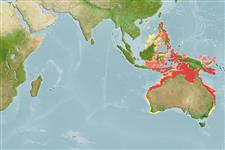|
Sepiida |
Sepiidae
Environment: milieu / climate zone / depth range / distribution range
Ecologie
; diepteverspreiding 10 - 155 m (Ref. 1695). Tropical; 20°N - 37°S, 112°E - 154°E (Ref. 1695)
Indo-West Pacific: from Australia to Philippines.
Length at first maturity / Size / Gewicht / Leeftijd
Maturity: Lm ? range ? - ? cm Max length : 11.0 cm ML mannelijk/geslacht niet bekend; (Ref. 1695)
Epibenthic (Ref. 116259). Shelf species on silt, sand or muddy substrates. Active during night. Forages in seaweed and seagrass beds (Ref. 1695, page 106).
Life cycle and mating behavior
Geslachtsrijpheid | Voortplanting | Kuitschieten | Eieren | Fecundity | Larven
Members of the class Cephalopoda are gonochoric. Male and female adults usually die shortly after spawning and brooding, respectively. Mating behavior: Males perform various displays to attract potential females for copulation. During copulation, male grasp the female and inserts the hectocotylus into the female's mantle cavity where fertilization usually occurs. Life cycle: Embryos hatch into planktonic stage and live for some time before they grow larger and take up a benthic existence as adults.
Jereb, P. and C.F.E. Roper (eds.). 2005. (Ref. 1695)
Status op de Rode Lijst van het IUCN (Ref. 130435)
Status bij CITES (Ref. 108899)
Not Evaluated
Not Evaluated
Gevaarlijk voor mensen
Gebruik door de mens
| FishSource |
Tools
Meer informatie
Leeftijd/Grootte
Groei
Lengte-gewicht parameters
Lengte-lengte parameters
Morfologie
Larven
Abundantie
Internet-bronnen
Estimates based on models
Preferred temperature
(Ref.
115969): 24.3 - 28.3, mean 27 (based on 296 cells).
Kwetsbaarheid
Low vulnerability (10 of 100).
